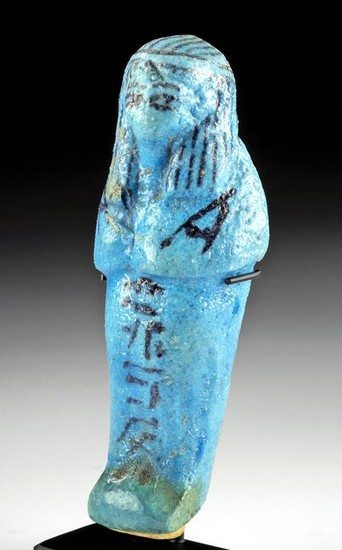Egyptian Faience Ushabti, Cornflower Blue Glaze
**Originally Listed At $3000**
Ancient Egypt, Third Intermediate Period, 21st to 25th Dynasty, ca. 1070 to 664 BCE. A stunning mold-formed faience ushabti enveloped in lustrous glaze of a brilliant cornflower-blue hue with additional aesthetic details presented in black pigment. The figure stands in mummiform with fused legs and feet, has a raised ridge above the waist that denotes the arms, holds the black-painted symbolic pick and hoe in hands crossed atop the chest, displays a large seed bag on the verso, and has broad shoulders that taper to a thick neck. Huge ovoid eyes and slender brows constitute the minimalist visage, and the head is topped with a striped tripartite wig. A black-painted hieroglyphic inscription column is presented atop the front of the legs and, while untranslated, provides the name of Osiris as well as that of the deceased. A gorgeous example of ancient Egyptian funerary tradition! Size: 1.7" W x 4.6" H (4.3 cm x 11.7 cm); 5.1" H (13 cm) on included custom stand.
Shabti (or ushabti) dolls are figures shaped like adult male or female mummies wearing traditional ancient Egyptian headdresses. The ancient Egyptians believed that after they died, their spirits would have to work in the "Field of Reeds" owned by the god of the underworld, Osiris. This meant doing agricultural labor was required by all members of society, from workers to pharaohs. By the Third Intermediate period, this practice had become so necessary and elaborate that some tombs contained one worker for every day of the year and thirty-six overseers, each responsible for ten laborers. The wealthier nobility in Egyptian society were able to have shabtis made of coveted faience, and blue faience was meant to reflect the color of the river Nile both on earth and in the afterlife.
Provenance: private Colorado, USA collection; ex-private Pennsylvania, USA collection; ex-William Ashby estate collection, California, USA, acquired in the 1980s
All items legal to buy/sell under U.S. Statute covering cultural patrimony Code 2600, CHAPTER 14, and are guaranteed to be as described or your money back.
A Certificate of Authenticity will accompany all winning bids.
We ship worldwide to most countries and handle all shipping in-house for your convenience.
#148903
Condition Report: Repair to lower tip of one wig fold, with small losses and light adhesive residue along break lines. Restoration to front of feet, with resurfacing and overpainting along new material and break lines. Minor abrasions and nicks to legs, body, and head, with light encrustations. Nice earthen deposits and amazing remains of original blue and black pigment. Small resin plinth added beneath restored feet for stabilization.
View it on
Estimate
Time, Location
Auction House
**Originally Listed At $3000**
Ancient Egypt, Third Intermediate Period, 21st to 25th Dynasty, ca. 1070 to 664 BCE. A stunning mold-formed faience ushabti enveloped in lustrous glaze of a brilliant cornflower-blue hue with additional aesthetic details presented in black pigment. The figure stands in mummiform with fused legs and feet, has a raised ridge above the waist that denotes the arms, holds the black-painted symbolic pick and hoe in hands crossed atop the chest, displays a large seed bag on the verso, and has broad shoulders that taper to a thick neck. Huge ovoid eyes and slender brows constitute the minimalist visage, and the head is topped with a striped tripartite wig. A black-painted hieroglyphic inscription column is presented atop the front of the legs and, while untranslated, provides the name of Osiris as well as that of the deceased. A gorgeous example of ancient Egyptian funerary tradition! Size: 1.7" W x 4.6" H (4.3 cm x 11.7 cm); 5.1" H (13 cm) on included custom stand.
Shabti (or ushabti) dolls are figures shaped like adult male or female mummies wearing traditional ancient Egyptian headdresses. The ancient Egyptians believed that after they died, their spirits would have to work in the "Field of Reeds" owned by the god of the underworld, Osiris. This meant doing agricultural labor was required by all members of society, from workers to pharaohs. By the Third Intermediate period, this practice had become so necessary and elaborate that some tombs contained one worker for every day of the year and thirty-six overseers, each responsible for ten laborers. The wealthier nobility in Egyptian society were able to have shabtis made of coveted faience, and blue faience was meant to reflect the color of the river Nile both on earth and in the afterlife.
Provenance: private Colorado, USA collection; ex-private Pennsylvania, USA collection; ex-William Ashby estate collection, California, USA, acquired in the 1980s
All items legal to buy/sell under U.S. Statute covering cultural patrimony Code 2600, CHAPTER 14, and are guaranteed to be as described or your money back.
A Certificate of Authenticity will accompany all winning bids.
We ship worldwide to most countries and handle all shipping in-house for your convenience.
#148903
Condition Report: Repair to lower tip of one wig fold, with small losses and light adhesive residue along break lines. Restoration to front of feet, with resurfacing and overpainting along new material and break lines. Minor abrasions and nicks to legs, body, and head, with light encrustations. Nice earthen deposits and amazing remains of original blue and black pigment. Small resin plinth added beneath restored feet for stabilization.



